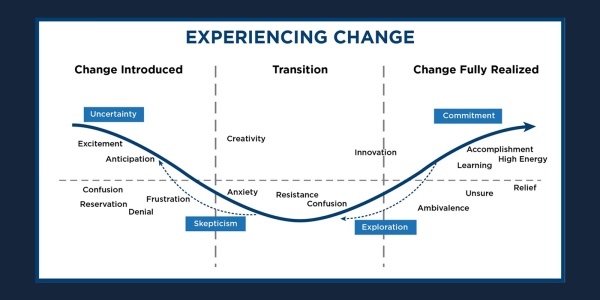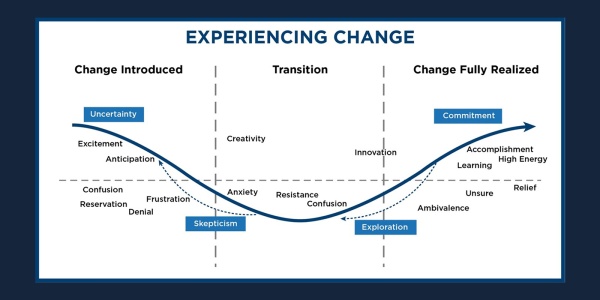When it comes to change, experts agree on one thing: Organizations must change, or they die. While most acknowledge the importance of change, they still don’t fully understand the change process and why it is so difficult. Implementing change is hard, and while a lot has been written about its importance, it remains a conundrum. With over 45 years of research and experience assisting our members to grow, improve and change, what APQC has learned is that for change to be effective, any change process involves three elements:
- People – an organization cannot introduce change without its people having understood the change and the factors driving it. While individuals often understand the intellectual basis for change, especially when it involves technologies and a demonstrated need to improve processes, to successfully implement, they must first accept and buy into the need for change, regardless of the drivers.
- Process – organizational processes are defined by policies, procedures, and rules that document, in detail, how work is performed. In change-centric organizations, process management is frequently the driver of change as processes are continually being tweaked, redesigned, and realigned as new ways of working are discovered to continually advance the ability to meet customer and organizational needs.
- Technology – Technology has long been a driver of change. With the introduction of Digital Transformation, Big Data, Artificial Intelligence, and more, organizations are turning to technology to assimilate, analyze and process information quickly and accurately. Often the desire to perfect business processes includes the adoption of new technology. But even if technology is not driving the change, technology will undoubtedly be a key component of any change process.
It is not the strongest of the species that survives, nor the most intelligent that survives. It is the one that is most adaptable to change.
–Charles Darwin
Where most organizations fail is within the people element. Organizations often fail to identify and communicate the need for change in a way that is understood and embraced by people who are working at all levels of an organization. This is not to say that all levels need the same information, however, change management must include communication that lays out the information needed for each, how it will be communicated, who will communicate, and the frequency of communication.
The Unforeseen Consequences of Change Management
The gotcha, in communicating change is that managers fail to consider how change may be received on intellectual, emotional, and most significant physiological and neurological levels by the people where the biggest impact of the change will be experienced.
A study conducted by ESI International found that change triggers fear and stress, creating a complex physiological and neurological reaction.
- The pre-frontal cortex region of the brain receives the transmission through one or more physical senses.
- The pre-frontal cortex then compares the new condition with the current condition by accessing another region of the brain, the basal ganglia, which stores the data we receive and contains the wiring for the habits we have.
- If a difference between the new condition and the existing condition is detected, an error signal is produced and sent throughout the brain.
- The error signal is received and tells us to be wary of danger and the brain sounds a warning alarm which triggers an emotion of fear.
- The new condition (the change) is then resisted by the pre-frontal cortex, which results in the person becoming wary, and backing away or resisting the change.

Knowing that change is fundamental to organizational success yet triggers a complex response in employees. Here are steps an employer can take to avoid the stumbling blocks associated with change.
- Get the attention of the people that need to embrace the change. Have conversations early and often. Don’t avoid getting people to address their fears by sharing the what, the why, the when, and the how.
- Engage individuals that will be impacted by the change with information that will help them process, by recognizing there will be varying degrees of informational needs required to prevent them from becoming wary or resistant. In taking such an approach you will create supporters of the change among others.
- Be cognizant of the need to align disturbances between the neurological conflicts based on the way the individuals did things or thought about things before the change concepts are introduced. This is done by creating common ground between the old way and the new way of operating and providing the mental map, of what needs to be learned to operate in the new/future state.
